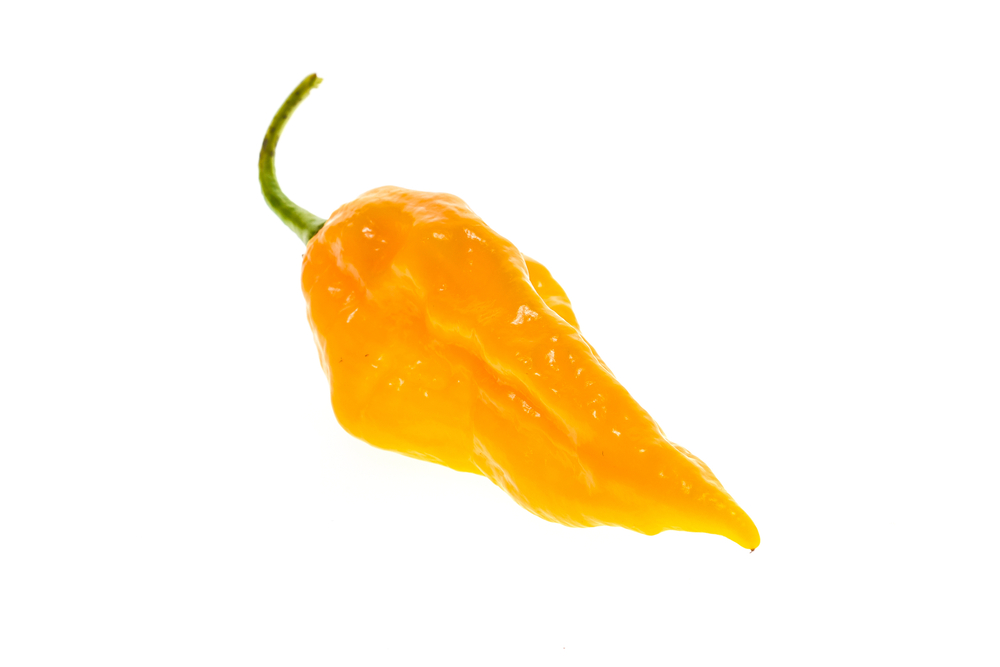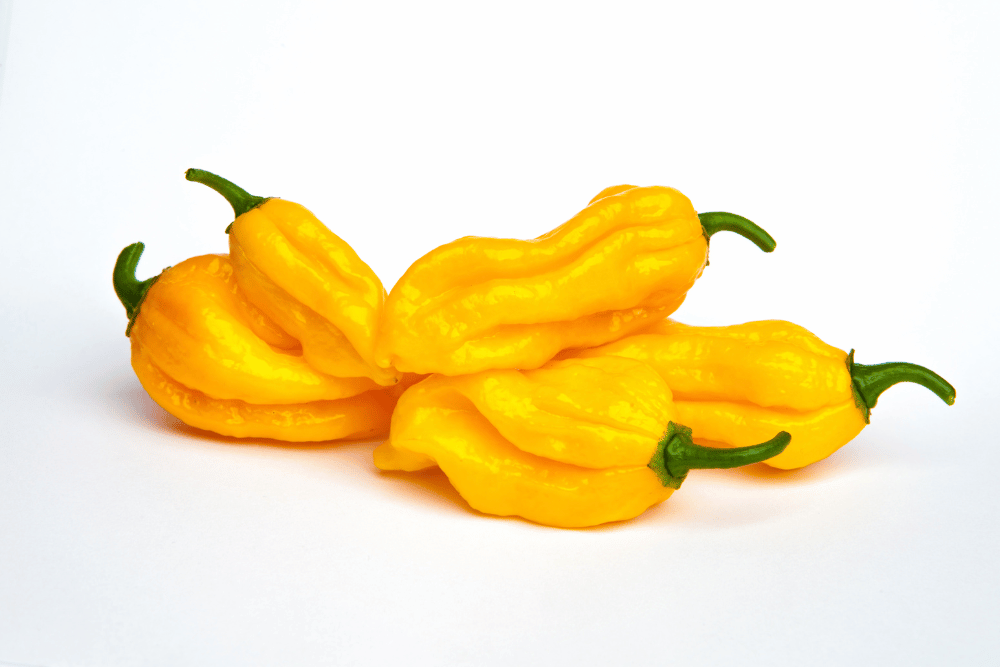The devil's tongue pepper was discovered in the US in the 1990s and subsequently developed for its heat, sweet flavor, and high productivity. It is believed to belong to the habanero family as a derivative of habaneros and fatalii peppers.
What Is The Devil’s Tongue Pepper?
The devil’s tongue pepper is a wickedly hot chili pepper discovered and developed by an Amish farmer in Pennsylvania in the 1990s.
The exact origins of the devil’s tongue pepper aren’t known, but the Amish farmer discovery story is the most plausible and reliable. Its discovery is much like the red savina habanero, which Frank Garcia of GNS Spices spotted growing in a field of orange habaneros.
The Amish farmer discovered golden yellow peppers growing in his field of habaneros, naming them the yellow devil’s tongue pepper because of their shape and hotness.
It’s believed the devil’s tongue pepper is a close relative of habanero and fatalii peppers because it has striking similarities to these peppers in shape, size, and heat level.
The devil’s tongue pepper is also sometimes called the devil’s tongue habanero because of its descent and striking resemblance to habanero peppers. It’s scientifically a Capsicum chinense variety.
Color
The original devil’s tongue pepper discovered by the Amish farmer was golden yellow at full maturity. Other variations of the pepper have since emerged, such as:
- Red devil’s tongue pepper
- Chocolate devil’s tongue pepper
- White devil’s tongue pepper
All devil’s tongue pepper varieties ripen from green. The red variety ripens to dark red, while the chocolate ripens to dark chocolate.
The white devil’s tongue pepper is rarer than the other varieties and ripens from pale lime green to purple to cream white (white with a faint yellow hue).
Unless the color is specified, any reference to the devil’s tongue pepper is usually about the yellow variety. It ripens from green to yellow-orange or bright yellow.
Size And Shape
The devil’s tongue pepper resembles the fatalii pepper in size and shape, though it’s smaller. It grows up to three inches long and 1-1.5 inches wide at full ripening.
Devil’s tongue peppers partly get their name from their eerie shape. They are slender and taper to a point that resembles the tip of a stuck-out tongue.
Coupled with the tongue-like appearance, the folded and twisted profile of the peppers and the wrinkly appearance give it a devilish appearance!
Texture
The texture of the devil’s tongue pepper is similar to that of the fatalii pepper, but its skin is smoother. The pepper is wrinkly, curvy, and eerily folded and twisted.

What Does The Devil’s Tongue Pepper Taste Like?
Contrary to its mean look, the devil’s tongue pepper has a sweet, fruity, citrus flavor with a slightly tangy undertone. It’s sweeter than the fatalii pepper but not as citrusy.
Red devil’s tongue peppers are sweeter and hotter than the other pepper varieties. The chocolate variety is sweet and slightly smoky.
How Hot Is The Devil’s Tongue Pepper?
True to its moniker, the devil’s tongue pepper is wickedly hot at 125,000-325,000 Scoville Heat Units. For context, fatalii peppers have the same heat level. Orange habaneros also have the same heat range at 100,000-350,000 SHUs.
However, the devil’s tongue pepper isn’t as fiery as Carolina reaper, bhut jolokia (ghost pepper), or Trinidad Moruga scorpion peppers. It’s wicked in that its heat registers long before the pepper’s sweet, fruity flavor.
Can You Eat The Devil’s Tongue Pepper?
Don’t be cowed by the pepper’s wicked look and heat level—it’s perfectly safe to eat it. The one thing to watch out for is the heat striking first before the sweetness and fruitiness register.
How To Use The Devil’s Tongue Pepper
Devil’s tongue peppers have various culinary applications because of their heat and flavor. You can use them to make devil’s tongue hot sauce, hot salsas, and other hot sauces.
The peppers are ideal for drying, dehydrating, and grinding into devil’s tongue chili powder.
Because of their thick walls, devil’s tongue peppers are ideal for pickling.
You can also use the peppers to flavor stews, soups, and chilis.
Recipes requiring habaneros and fatalii peppers can be swapped out for devil’s tongue peppers if you have access to them.
Where To Buy The Devil’s Tongue Pepper
The devil’s tongue pepper is rare and has become an heirloom variety among home growers and pepper enthusiasts. You won’t find it at the typical brick-and-mortar supermarket or grocery store.
Fresh devil’s tongue peppers may be available from local pepper growers and farmers’ markets.
Can You Grow The Devil’s Tongue Pepper?
Like other rare pepper varieties, growing your own remains your best chance. Devil’s tongue peppers are easy to grow.

Amazon and online specialty seed catalogs carry devil’s tongue pepper seeds that you can use to grow high-yielding pepper plants outdoors in full sun.
You’ll have to start the seeds indoors or in a greenhouse 8-10 weeks before the last frost in moist soil at 70-75°F. Germination happens in 7-21 days.
Once the young pepper plants develop about six true leaves, transplant them outdoors in large containers or directly into the garden in moist, fertile, and well-drained soil.
Devil’s tongue peppers take their sweet time to mature. You’ll start harvesting the white variety in about 90 days and the others in 100-110 days.
Substitutes For The Devil’s Tongue Pepper
You can substitute the rare devil’s tongue pepper with fatalii peppers (125,000-325,000 SHUs) and typical habanero peppers (100,000-350,000 SHUs). These substitutes are also sweet and fruity.
You can also replace the peppers with other peppers in the habanero family, such as Caribbean red habaneros and red savina habaneros or habanero-related peppers like scotch bonnet chili peppers.

